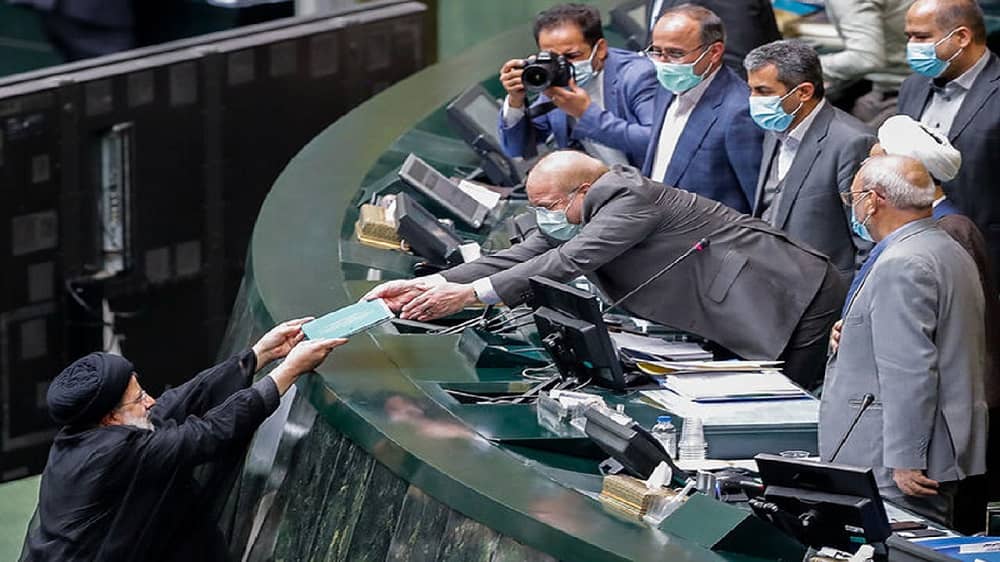

The budget sees an 18.2% increase, totaling 2,642 billion tomans, as the government grapples with managing the nation’s affairs amid economic challenges.
The budget is primarily funded through various sources, including taxes, oil sales, sales of government property, bond sales, and company divestments. Remarkably, tax revenue is the most significant contributor, projected at 1,122 billion tomans for the upcoming year. This marks a substantial 50% hike from the current year’s tax intake of 749 billion tomans.
In a controversial move, the Iranian regime plans to levy these increased taxes predominantly on ordinary citizens. Current financial data from regime institutions reveals that over 95% of the tax revenue, amounting to more than 711 billion tomans, has already been collected this year. This represents a 65% surge from the previous year’s 454 billion tomans, placing an additional financial strain on the populace, particularly in the production sector.
Watch and judge how #EbrahimRaisi wants to compensate for the #Iranian regime's budget deficit pic.twitter.com/smAnIYCTnE
— NCRI-FAC (@iran_policy) March 2, 2023
This tax increment comes at a time when Iran is facing an economic recession and rampant inflation. Typically, governments reduce taxes during financial downturns to alleviate economic strain, but Iran’s approach deviates from this norm. Instead, it has opted to raise taxes by 50%, further burdening its citizens.
The decision seems more pressing given the disparity between wage increases and inflation rates. Despite an official inflation rate of around 50%, President Ebrahim Raisi’s administration has only planned to boost the minimum wage by 18 to 20%. This widening gap between income and living costs is expected to further erode the purchasing power of Iranians.
Under the new tax regime, individuals earning over 10 million tomans will face taxation. With the poverty line around 30 million tomans, this policy is poised to plunge a majority of the population into official poverty, ensuring the regime secures resources for its projects and ambitions.
The impact of these economic policies is starkly evident in the inflated prices of goods, particularly cars. For example, a 2017 Kia Optima costs over 3 billion tomans in Iran, compared to 300-400 million tomans in the United Arab Emirates. The 2011 Toyota Aurion and the 2017 Benz E200 exhibit similar inflated prices in Iran, being 16 and nearly 12 times more expensive, respectively, than in Dubai.
In his speech, Raisi didn’t refer to how the budget’s lion’s share goes to the regime’s security apparatus and institutions under the supreme leader’s supervision, which are also exempt from taxes. #IranRevolution2023 https://t.co/8oXwafYWUl
— NCRI-FAC (@iran_policy) January 26, 2023
This price inflation, exacerbated by high inflation rates, compels Iranians to opt for domestically produced vehicles, which are often criticized for lacking safety standards and contributing to high road accident rates. These vehicles have even been derogatorily termed “death wagons.”
Further exacerbating the situation, financial entities linked to the Islamic Revolutionary Guard Corps, controlling 60% of the country’s capital, and other financial empires associated with Supreme Leader Ali Khamenei, enjoy complete exemption from taxation. This selective tax policy, which heavily burdens the general populace, could potentially fuel grassroots uprisings in a society already on edge.
Lastly, the regime’s anticipated oil income for 1403 is set at 585 billion tomans, a decrease from the previous year’s forecast of 604 billion tomans. This reduction suggests that claims of record-high oil sales and fund returns are primarily promotional, with the Raisi government acknowledging a downturn in oil revenues for the coming year.
In conclusion, Iran’s draft budget for the next fiscal year signals an intensified financial burden on its citizens. The government’s reliance on increased taxes to fund its operations amidst a recession and high inflation indicates a challenging economic landscape ahead.

MEK Iran (follow us on Twitter and Facebook), Maryam Rajavi’s on her site, Twitter & Facebook, NCRI (Twitter & Facebook), and People’s Mojahedin Organization of Iran – MEK IRAN – YouTu







